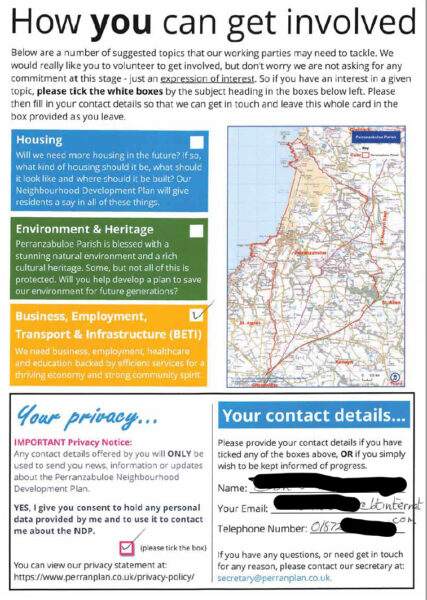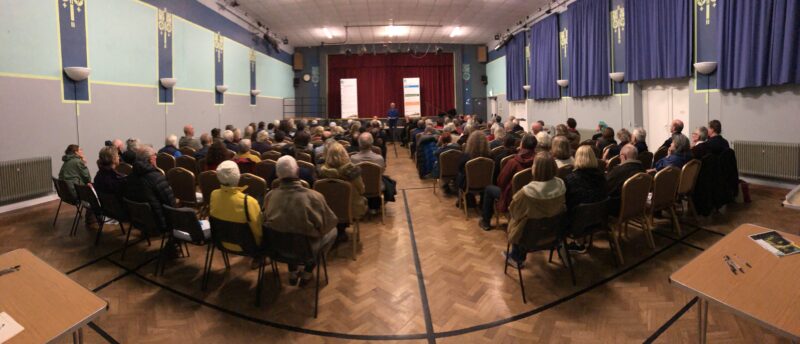As part of creating awareness of the NDP process starting, we had 3 public events in late November of 2018:
- Goonhavern Village Hall
– Tuesday 20th November, 2018: 7:30pm - Perranporth Memorial Hall
– Wednesday 21st November, 2018: 7:30pm - Chiverton Arms Blackwater
– Tuesday 27th November, 2018: 7:30pm
All 3 events increased the number of people who signed up to be kept updated as to progress. The details were added to our Mailchimp e-mailing list. Tally of paper sign up forms from these events
- Goonhavern, 20 sign up forms
- Perranporth, 59 sign up forms
- Chiverton, no sign up forms.
This took our e-mail list (Mailchimp) from 33 to 127 and within a few days of the evnts 135.
– 2023 update: The Mailchimp mailing list grew steadily to 153 recipients being email notified re the October 2019 meetings to discuss the initial survey findings.
The main notes used for the presentation done at these events are below.
A redacted example of the sign up form is below:

As expected given that Perranporth it’s the largest settlement in the parish, this was the most attended event of the 3:

Presentation Notes used for these events:
Can everybody hear me?
I’m Rory, current chair of the Neighbourhood Development Plan team for this parish.
- William, thankyou for the health and safety information.
- Michael, thankyou for the ongoing support you and the rest of the parish council are giving our Neighbourhood Development Plan and it’s team of volunteers.
- BUT MOSTLY, thankyou to everybody for coming along this evening.
The format of this evening is going to be that:
- I’m going to outline what a Neighbourhood Development Plan is and why we believe we should have one.
- Then the heads of the 3 groups we have are going to talk about what they hope an Neighbourhood Development Plan (NDP) might achieve in relation to their specific areas which are:
- Environment & Heritage
- Business, Employment, Transport & Infrastructure (BETI)
- Housing
- Then we’ll have a general questions session before we split up into:
- over here for general NDP questions,
- over there for Environment & Heritage
- over there for BETI, and
- over there for Housing.
OK, so what is a Neighbourhood Development Plan
It’s a mechanism for local communities to influence planning decisions where they live and work.
At the top, central government determines a top tier of policies and plans for developments.
Then, below that, the likes of Cornwall Council can create (and have created) a regional local plan.
Then, within the constraints of both the national and regional policies we can create an NDP for the very local level.
A key point here is that we must stick within the national and local policies and plans.
Once we have an NDP for our parish, planning decisions will have to consider our NDP.
To create an NDP:
- We have to create a Steering Group, which we’ve done.
- We have to get the OK from the parish council and Cornwall Council, which we’ve done.
- We have to create awareness which we are doing with the social media, a Website, the leaflets, posters …
- The next steps are to:
- See who else wants to be involved
- Create and send out a questionnaire of what people who live and work in the parish want.
- Collate the responses and make this into a proposed NDP.
- Have a referendum on this proposed NDP.
- If majority yes, submit it for formal approval into the planning system.
This is likely to take about 18 months, possibly 2 years, from now.
We need not only as many peoples views on issues we might be able to influence via an NDP but people who can help with the work. On a permanent or temporary basis. All help is great. We’re a bunch of unpaid, diverse enthusiastic volunteers.
So that’s a bit about what a Neighbourhood Development Plan is, why do we think we should have one?
Firstly, an NDP can steering some aspects of developments towards what the community wants. For example, protecting the environment and natural landscape, the impact on business and other infrastructure and where developments happen.
Two Cornwall examples of this are:
1st Example. St Ives managed to put in a Second Homes policy into their NDP. This will reduced developers focusing on projects targeting those who have no plan to live full time in St Ives.
2nd Example. Earlier I said an NDP sits below national and regional policy. A lot of you have probably heard that in Crantock a lot of people are upset that their NDP did not stop the approval of an expansion of an already approved development. Yes, that’s true, because of higher level legislation, but what I didn’t realise until I asked Roger, the lead of our housing team, is that because of what is in their NDP the developer was required to increase the Affordable Housing provision from 30% to 50%. For me, that’s a positive for Crantock.
Secondly, as you can gather from these 2 examples, an NDP can put onerous and potentially costly requirements on developers.
That means that if our parish does not have an NDP, but others do, developers have the potential to make more money in our parish and may therefore target our parish. Surrounding parishes either have or are are well on their way to having an NDP.
Thirdly, from the 1st of January 2019 there is going to be a Community Infrastructure Levy (CIL) of up to £100 per square meter floorspace. If our parish has an NDP, the parish council will get 25% of this to spend in the parish. If we don’t have an NDP the parish council will get 15%, so 10% less.
– if our NDP includes a ‘second-homes restriction policy’ CIL will drop to zero.
Forth. This project is likely to throw up other issues that, based on what has happened with other NDP projects, leads to a group forming and taking this on.
Quick Summary
An NDP can’t stop development it can nudge it towards what we want.
So lets find out what our community wants.
Then lets work out, from this what can be put in our Neighbourhood Development Plan.
Next up are the heads of our current groups:
- Christine for Environment & Heritage
- Kevin for BETI – Business, Employment, Transport & Infrastructure
- Roger for housing















